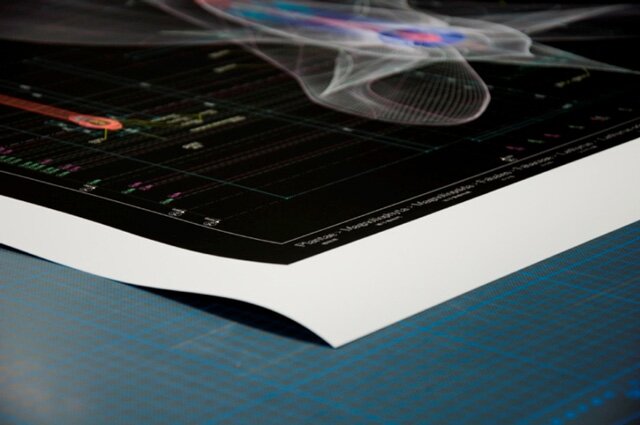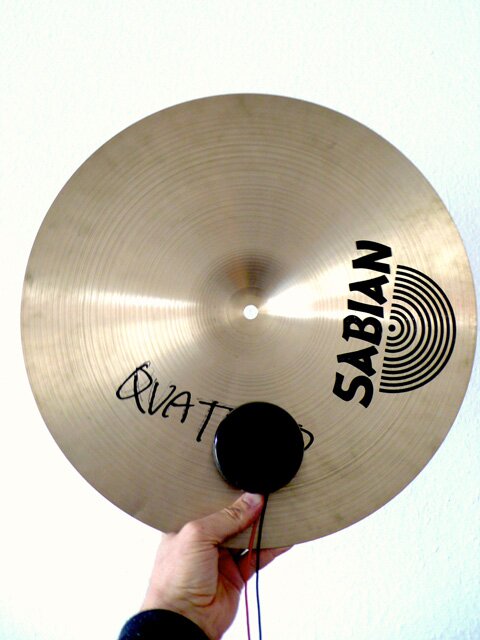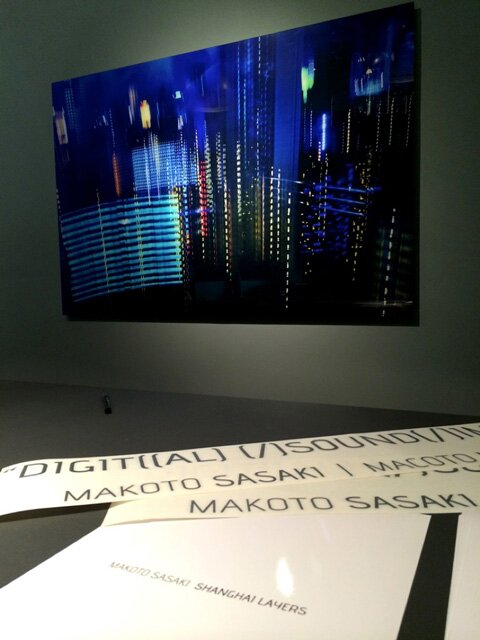
Stefan Goldmann’s music performance at the opening reception of
“Digit((al) (/)Sound(/)Image)(.)”

2014 April 4th (FRI) 19:00-22:00
Das Foto Image Factory, Berlin, Germany
Dj Set
While Das Foto Image Factory is the space where the relationship of digital image with its media/machines is reviled, we invited Berlin based Dj Stefan Goldmann to expose some intriguing links between digital sound and the wide range of means that while producing music shape it in its particular ways. The result of this meeting is an unusual synthesis/parallelism that launches in one place synchronic perception of media-image and media-music.

 Prints of “Inorganic Flora” by Macoto Murayama during its production at Das Foto Image Factory.
Prints of “Inorganic Flora” by Macoto Murayama during its production at Das Foto Image Factory.
Thus visitors of the show not only could enjoy the “fruits” of the digital domain, but were also confronted by machines that give birth and shape these cutting edge and heading into future arts. Here is how Goldman describes his approach to the topic showing some evolutionary aspects of digital sound as well as specifics of its contemporary embodiments:
“For a century, recording techniques and media have gone through a technological evolution aimed at growing bandwidth of frequency range, dynamics and spatial resolution. With the regress into compressed digital formats (an mp3 has lower bandwidth than a CD) and the now obvious marginality of beyond-stereo spatialization (outside of multiplex cinemas), the history of audiophile progress seems to have come to a halt and to have turned into a legitimate source of form capable of shaping music itself at the same time: Music it was supposed to serve only, not to form.
Most of today's music finds its final embodiment in a digital stereo master file (not in a score, not in a performance), encoded at a bit rate of 16 or higher and a sampling frequency of 44.1 kHz or higher. Anything else is aesthetics - or esotericism. It could actually be argued that even the master-as-file has become optional: reconstructed from samples and presets, it is quickly recovered - from a crash or whatever else made it disappear.

Stefan Goldmann during his performance in Das Foto Image Factory.
Various side effects of the technical progress of amplification and recording have been central to music creation for a long time: think of distortion. For the first time in history though the entire palette of sonic format specifics is readily available for use as an extension of what "instrumentation" used to be. The commercial availability of the respective technology-emulating tools in the form of software plug-ins says it all. Long "obsolete" technology is revived, within the boundaries of its technical successors, not because of its evolutionary advantages, but for its specific colouration.
Format specifics, like vinyl's geometric distortion, high frequency compression and low end linear-phase, or the specific harmonic distortion of a valve tube, digital degradation effects reminiscent of earlier technology etc. thus become aesthetic (instead of: technical) tools used not to enhance quality, but to transform it. Formats are now nothing but a filter put between a "clean" sound source and an ear, for the sole purpose of aesthetic differentiation.
This has been anticipated for some primary format specifics, especially regarding their "faults": from Christian Marclay's vinyl manipulations, including the probably first occurrence of something like distribution art: "Record Without a Cover", to Oval's scratched CD surfaces, to a broad practice of glitch, clicks and cuts … See my Haven't I Seen You Before (2010), The Grand Hemiola (2012), Ghost Hemiola (2013) works for further examples of transforming format limitations into aesthetic devices of form.
With the DJ set at the opening of “Digit ((al) (/)Sound(/)Image)(.)” Exhibition in Das Foto Image Factory, the preparation consisted of making the sonics of format specifics directly available as expressive means, putting the DJ in control of addressing these, liquidly, "in the mix." Audio recording and reproduction media can be broken down into three rough categories: mechanic, analog electro-acoustic and digital (which is eventually converted to analog electro-acoustic on its way in and out of the digital domain). Mechanical sound recording and reproduction was the method employed first with Edison's early recordings on tin foil and wax cylinders - from the Phonograph to the early Gramophone Shellack era. Eventually, electric amplification enhanced a process that could be mechanical (a needle being caused to vibrate by a structured groove on a vinyl surface) or electro-magnetic (metal particles arranged in changing patterns, affecting a magnetic field). Finally, digitalization represented sound waves as chains of digits - sampled states of sound waves, numerically represented.
During the set, a record turntable provided an analog source, which could be made painstakingly "visible" with the Ghost Hemiola record: an empty record is cut with a knife, so that no recording, but the actual analog carrier becomes audible. A laptop, two CD decks and a digital effects section in the DJ mixer represented the digital domain, with several processes available for colouring sound.
The mechanical domain was represented by a spring reverb and a "Métallique" resonator. Both devices were triggered electrically, but the point was to address their capacity of emanating sound waves while colouring these through their physical design. With a spring reverb, a metal spring is caused to vibrate. These vibrations continue for some time after the stimulus, thus generating an echo or reverb effect. With the unit employed here, the springs were openly accessible, so they could be addressed manually, i.e. mechanically too. This is audible as outbursts of metallic noise during the set.

Spring reverb used during the performance.
Originally developed for the Ondes Martenot electronic instrument in 1928, the "Métallique" is a loudspeaker construction with a brass / metal surface as a membrane, stimulated by an electro-magnetic driver. The one employed here is a custom-built reincarnation with a pierced cymbal and a handful of electronic components. The level of clank and low frequency response in the signal depend mostly on the degree of contact with the table underneath the "Métallique". Dampening its surface alters the sound response dramatically. When the surface is touched by hand, the sound is felt physically - as if someone is hitting the cymbal from underneath the table. At the same time, the cymbal can be hit and played as such. Interacting with the singing and clapping of Son House that was sent to the "Métallique" thus enables a perceived dialogue, bridging several decades.

Métallique Resonator used at performance.
The "clank" and metallic distortion produced by this unit are typical artifacts of mechanical sound reproduction: the search for a material capable of emanating "natural" sound has been a series of compromises between loudness, frequency response and distortion. Eventually, changes in frequency response and distortion, former undesired artifacts, emancipated as timbres in their own right. This is very clearly audible here.
In the digital domain, emulations of a valve stage, vinyl distortion and digital distortion could be switched in and out by hitting a controller, i.e. they acted as what they are: timbre. The difference here towards their regular presence is that they could be applied rhythmically, stressing parts of the audio and musical form. With a set of digital filters and time-stretching algorithms recordings from wildly different eras could be split up and re-arranged to form layered renderings of music. At some points there are parts of up to six different recordings played back simultaneously. Specifics of slowed down vinyl rotation, time-stretching digital artifacts, etc are audible at points and become part of the audio stream. Eventually the differences melt away in perception and a unified, continuous experience might emerge after all.”

Exhibition view with Makoto Sasaki’s “Shanghai Layers#04”
>> More information about Macoto Murayama
>> More information about Makoto Sasaki
>> More information about Stefan Goldmann
Exhibition Details:
Exhibition Title: “Digit((al) (/)Sound(/)Image)(.)”Participating Artists: Makoto Sasaki and Macoto Murayama (featured by Stefan Goldmann)
Organized by: Frantic Gallery (Tokyo) and Das Foto Image Factory (Berlin)
Curated by: ENTOMORODIA curatorial net/work
Place: Das Foto Image Factory, Berlin, Germany
Dates: 2014 April 4th (FRI) – May 30th (FRI)
Time: Monday – Friday, 9:00 – 19:00
Opening reception: 2014. April 4rd (FRI) 19:00-22:00
Stefan Goldmann DJ mix: 2014 April 4rd (FRI) 20:00-21:00
Address: Wilhelmstraße 118 D 10963 Berlin
Das Foto Image Factory URL: http://www.dasfoto.net/
Access: http://www.dasfoto.net/kontakt/








 frantic.jp
frantic.jp